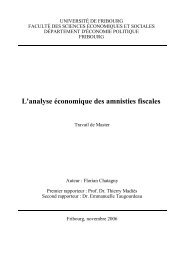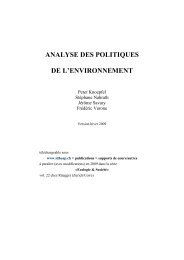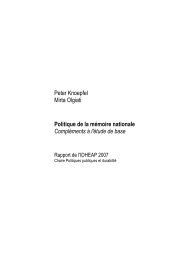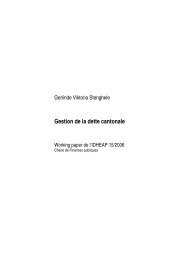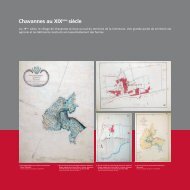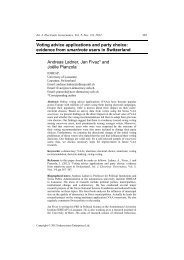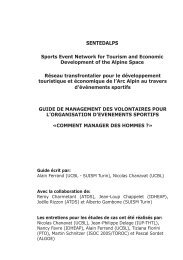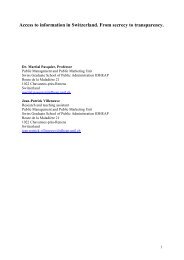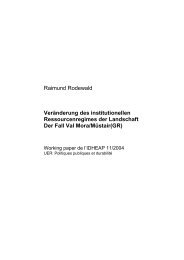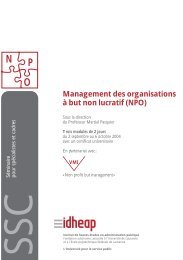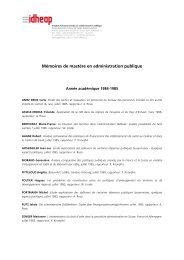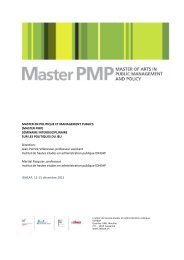Historical Analysis of Institutional Regimes in Switzerland ... - IDHEAP
Historical Analysis of Institutional Regimes in Switzerland ... - IDHEAP
Historical Analysis of Institutional Regimes in Switzerland ... - IDHEAP
You also want an ePaper? Increase the reach of your titles
YUMPU automatically turns print PDFs into web optimized ePapers that Google loves.
4<br />
b) The limits <strong>of</strong> the economic approach<br />
<strong>Institutional</strong> economics makes an important contribution to the analysis <strong>of</strong> resource management <strong>in</strong><br />
that it draws attention to the function <strong>of</strong> property rights as steer<strong>in</strong>g factors and exam<strong>in</strong>es the effect<br />
they have on the more or less susta<strong>in</strong>able use <strong>of</strong> resources. In our op<strong>in</strong>ion, however, this<br />
predom<strong>in</strong>antly static <strong>in</strong>stitutional perspective also has its limitations which are <strong>in</strong>dicated below:<br />
• The consideration <strong>of</strong> regulative systems alone is not sufficient for a comprehensive analysis<br />
<strong>of</strong> resource use and management; it must also be analysed <strong>in</strong> the context <strong>of</strong> the resourcespecific<br />
public protection and use policies.<br />
State regulation <strong>of</strong> the production and/or consumption <strong>of</strong> certa<strong>in</strong> goods and services provided by a<br />
natural resource is a common occurrence <strong>in</strong> everyday political life (cf. hunt<strong>in</strong>g regulations <strong>in</strong> the Swiss<br />
cantons, residual water regulations for Swiss hydro-electric power plants). In most cases, there are<br />
several public policies which regulate the use <strong>of</strong> a resource and which can result <strong>in</strong> the degradation <strong>of</strong><br />
that resource due to their <strong>in</strong>sufficient co-ord<strong>in</strong>ation (cf. water protection and degradation <strong>of</strong> ground<br />
and surface water due to the promotion <strong>of</strong> <strong>in</strong>tensive agricultural policies). Thus, consideration <strong>of</strong> the<br />
regulative systems alone is not sufficient for the analysis <strong>of</strong> the <strong>in</strong>stitutional framework. In fact, the<br />
<strong>in</strong>fluence <strong>of</strong> all relevant public policies on a specific commodity or the entire resource, and their<br />
<strong>in</strong>teraction with the given property and use right arrangement, should be given explicit consideration<br />
(Bättig et al. 1999).<br />
• The emergence and change <strong>of</strong> <strong>in</strong>stitutional regimes should be the focal issue: a dynamic<br />
perspective is required.<br />
In our op<strong>in</strong>ion, <strong>in</strong>stitutions should not merely be understood as given frameworks, with<strong>in</strong> which<br />
actions are carried out. Like public protection or use policies, they too are the product and <strong>in</strong>tegral<br />
components <strong>of</strong> the political process. Most <strong>of</strong> the literature concentrates on the analysis <strong>of</strong> the<br />
regulative systems which exist today. Lesser emphasis will, therefore, be placed on the perspective<br />
deal<strong>in</strong>g with analysis <strong>of</strong> the process. In order to avoid further degradation <strong>of</strong> resources, it is,<br />
however, important to know when and under what conditions <strong>in</strong> the political process the <strong>in</strong>stitutional<br />
regimes can be changed and how this can be brought about and managed.<br />
• Specific public policies are becom<strong>in</strong>g <strong>in</strong>creas<strong>in</strong>gly important due to the fact that resource<br />
use requirements are becom<strong>in</strong>g more heterogeneous and self-organisation will not suffice<br />
as a form <strong>of</strong> problem resolution.<br />
Ostrom's earlier approach (1990) focuses on common-pool resources and - particularly <strong>in</strong> the earlier<br />
studies on irrigation - is based on the assumption <strong>of</strong> a homogeneous demand for local commodities<br />
and services. In this <strong>in</strong>stance, it was possible to prevent the degradation <strong>of</strong> resources on the basis <strong>of</strong><br />
voluntary co-operation, i.e. without state <strong>in</strong>tervention. Although this can be viewed as a very efficient<br />
strategy from an economic perspective, this k<strong>in</strong>d <strong>of</strong> solution is probably uncommon <strong>in</strong> highly<br />
developed societies characterised by <strong>in</strong>creas<strong>in</strong>gly heterogeneous demands and an expand<strong>in</strong>g scope<br />
<strong>of</strong> effects - factors which dictate aga<strong>in</strong>st a local and regional solution such as common property.<br />
Thus, guidance <strong>of</strong> heterogeneous, grow<strong>in</strong>g and <strong>in</strong>creas<strong>in</strong>gly rivalrous use demands is required.<br />
• Self-organisation was sometimes facilitated by the fact that the negotiations were held <strong>in</strong><br />
the shadow <strong>of</strong> hierarchical authority, i.e. rules were backed up by hierarchy.<br />
In some cases, it is impossible to f<strong>in</strong>d any formal traces <strong>of</strong> state <strong>in</strong>tervention, nevertheless selforganisation<br />
was only possible <strong>in</strong> the shadow <strong>of</strong> hierarchy (Scharpf 1993: 145). In this context, selforganisation,<br />
i.e. the generation <strong>of</strong> rules, is <strong>in</strong>tertw<strong>in</strong>ed with public policy: the spectrum ranges from



